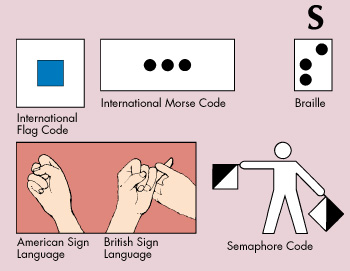S is the 19th letter of the alphabet used for the modern English language. It is also used in a number of other languages, including French, German, and Spanish. See Alphabet .

S has several sounds that are common in English. The letter S can have a sibilant (hissing) sound. This occurs in such words as sing, last, plus, and fuss. Between vowels, S often represents the voiced Z sound, as in busy. The S is silent in such words as aisle or debris.
Scholars believe that the letter S evolved from an Egyptian hieroglyph (pictorial symbol) representing a papyrus plant. Hieroglyphs were adapted to be used for a Semitic language by around 1500 B.C. The alphabet for this Semitic language—the earliest known alphabet—is called Proto-Sinaitic. By 1100 B.C., an alphabet for another Semitic language, Phoenician, had evolved from Proto-Sinaitic. See Semitic languages .
The Phoenician letter that can be traced to the Egyptian papyrus hieroglyph is the 21st letter of the Phoenician alphabet, tsad. The Phoenicians used the letter to represent the beginning TS sound of the word tsad, which was their word for cricket. Around 800 B.C., when the Greeks adapted the Phoenician alphabet, they used more than one letter to represent the S sound. One of those letters, san, looked like a capital M. But eventually, another letter, sigma, became the predominant letter used for S. The Etruscans adopted the Greek alphabet about 700 B.C. They also had more than one letter for S, but all varieties of Etruscan had a letter adapted from sigma. By around 650 B.C., the Romans adopted the alphabet from the Etruscans. The Latin alphabet used only one letter to represent the S sound.

